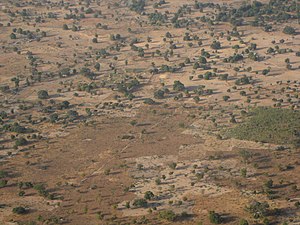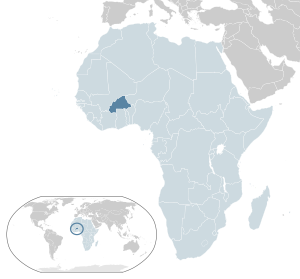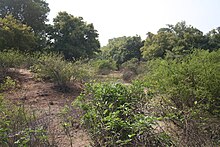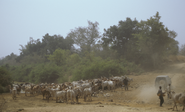Wildlife of Burkina Faso


To ensure conservation and preservation of the wildlife of Burkina Faso, four national parks have been established. These are the
Geography
Wildlife area in the landlocked
Based on ecological characteristics and climatic conditions, the country is divided under three bio-climatic zones namely, the Sahelian Zone, the Sudanian Zone and the Sudano-Guinean Zone. The Sahelian Zone covers 25% of the area of the northern part of the country, which is further subdivided under the Sahelian and sub-Sahelian sectors. In the Sahelian sector, where the rainfall is only of the order of 400 millimetres (16 in), the vegetation is mostly of shrubs and wooded grassland or steppe. The sub-Sahelian sector represents the transition zone, receives an average annual rainfall of 400–600 millimetres (16–24 in) and represents the transition between the Sahelian and Sudanian bioclimatic zones. The vegetation in this sector has moist Sudan savanna vegetation in the river valleys, while the western half is largely inhabited by humans; most of the large trees in the northern half of the sector are reported to have vanished due to climate change. The Sudan Zone receives higher rainfall in the range of 600–1,000 millimetres (24–39 in) and is further subdivided into three sectors namely, the central plateau sector, the Mouhoun sector and the Pendjari–Mékrou sector and has widely varying vegetation depending on human occupation for agriculture and mostly savanna vegetation, predominantly wooded savanna. the Pendjari–Mékrou sector with its floodplains and many ephemeral rivers, is less populated by humans but has the largest population of mammals in the country; vultures and raptors are also reported. The Sudano-Guinean Zone in the southwest corner of the country is a humid zone with an annual rainfall in the range of 1,000–1,200 millimetres (39–47 in). It is heavily wooded with wooded savannas and gallery forests; it has the ambience of a park with its widespread vegetation of Khaya senegalensis, Daniellia oliveri and Isoberlinia forests, tall grasses and savanna vegetation is also a dominant feature. Its human population distribution is low but the wildlife population is the second largest in the country.[5]
The area is drained by many rivers, the most important of them being the
Climate
Rainy season (June to September) is one of the four seasons in Burkina Faso; the other three being, an intermediate season from September to mid November, the summer of harmattan season of the Sahara hot and stormy winds (mid February to mid June) and the dry and winter cool season from mid November to mid February. During the rainy season is when the shrubs and stunted trees flourish in the savanna in the northern region where rainfall incidence is about 10 inches and the rivers flow full with dense vegetation growing in the southern region of the country when the rainfall incidence is as high as 40 inches (1,000 mm).[1]
National Parks
There are four important
Arli National Park

The
Deux Balés National Park
The Deux Balés National Park, is located in central eastern Burkina Faso, within
Kaboré Tambi National Park

The Kaboré Tambi National Park is situated between
W of the Niger National Park

The W of the Niger National Park was created in August 1954. It is a major national park of the three countries of Niger, Benin and Burkina Faso, and is governed by the three governments. It is around a
Fauna
As of 2006, Burkina Faso is considered to be one of the West African countries with the largest faunal population.[10]
Mammals
Mammals in Burkina Faso include
]The
Reptiles

Three
Birds
In Burkina Faso, as of 2005, 497 bird species of various families, including 35
Ten Important Bird Areas (IBAs) which cover about 20,260 km2 (7,820 sq mi) (7.4% of the area of the country). These have Sudan–Guinea Savanna biome (A04) (with 30 of the 32 species of this biome), Sahel biome (A03) (with six of eight biome species) and with breeding colony of
Insects
- Lepidoptera
Flora

The flora of Burkina Faso is composed of 2067 plant species.[2] The most important families in terms of species richness and abundance are the grasses (Poaceae) and legumes (Fabaceae).[15] Many species are distributed widely in the savannas regions of Africa. There are however two endemic plants, Pandanus brevifrugalis and Isoetes jaegeri.[2]
Approximately 15% of the country has forest cover while wooded land constitutes approximately 34% of the area. Very little closed forest can be found and this is mainly of the
Poverty means that deforestation is a problem in the country and each year the country loses approximately 32,000 hectares of forests, to make way for agriculture and for fuelwood, which around 90% of the national population are dependent upon.[16] Numerous NGOs are active in the country, educating farmers and encouraging them to minimize land clearing and plant trees as well as cultivate the land.
Trees of note include the
The country contains populations of
Conservation
Fauna conservation areas were first established in 1926, which included five 'parcs de refuge' that covered 536,700 ha.[19]
In conservation and sustainable resources management efforts, the IBA Local Conservation Group with help from BirdLife Partners around the world have set up "site support groups" in Burkina Faso, which was initially begun in 1959 to count birds. This resulted in the training of local volunteers as
References
- ^ a b c d e f g h i "Burkina Faso:Plants and animal life". Encyclopædia Britannica. Retrieved 24 April 2011.
- ^ ISBN 978-2-8277-0081-3
- ^ a b c d e f "Wild Shea Tree Benifitting [sic] Burkina Faso: Women Engaged in Shea Sector Gain From Trade In 'Shea Butter'". Gender and Trade: Commonwealth Secretariat. Archived from the original on 5 June 2011. Retrieved 24 April 2011.
- ISBN 978-92-5-104785-9. Retrieved 24 April 2011.
- ^ a b c d e f g "Burkina Faso" (PDF). BirdLife International. pp. 117–123. Archived from the original (PDF) on 15 October 2012.
- ^ "Deux Balés National Park". UNEP-WCMC. Archived from the original on 5 November 2010.
- ^ Onishi, Norimitsu (10 May 2001). "Baporo Forest; A Stately Elephant Moment, a Bit Like an Elegy". The New York Times. Retrieved 28 April 2011.
- ^ a b c d "Burkina Faso: Partnership for Natural Ecosystem Management Program (PAGEN)" (PDF). Global Environment Facility. 2 May 2002. pp. 5–7, 57.
- ^ "W of the Niger National Park". parc-w.net. Archived from the original on 4 October 2011. Retrieved 28 April 2011.
- ^ International Monetary Fund; Burkina Faso. Ministry of Economy and Development (2005). Burkina Faso: Poverty Reduction Strategy Paper. International Monetary Fund. pp. 48–. GGKEY:WNFW0FHLYBH.
- ^ ISBN 978-2-8317-0733-4.
- ISBN 978-2-8317-0442-5. Retrieved 25 April 2011.
- ISBN 978-2-8317-0060-1.
- ^ "Avibase – Bird Checklists of the World:Burkina Faso". Avibase-The world bird data base. Retrieved 24 April 2011.
- ^ Marco Schmidt: Pflanzenvielfalt in Burkina Faso. Analyse, Modellierung und Dokumentation. 2006
- ^ Sawadogo, Jean-Marie (October 1997). "Burkina Faso protects its fragile soils: Environmental sustainability is key to agricultural revival". Africa Recovery. 11 (2). United Nations: 20. Archived from the original on 8 November 2009. Retrieved 24 April 2011.
- ^ ISBN 978-92-9043-299-9.
- ^ ISBN 978-92-5-104376-9.
- ISBN 978-2-8317-0092-2.
- ^ "Twelve years of site support in Burkina Faso". Birdlife International. 29 January 2010. Archived from the original on 30 November 2010. Retrieved 25 April 2010.





